【课堂笔记】2020年春季初一英语博学班(全国版)-潘焕明老师
- 格式:pdf
- 大小:773.79 KB
- 文档页数:11
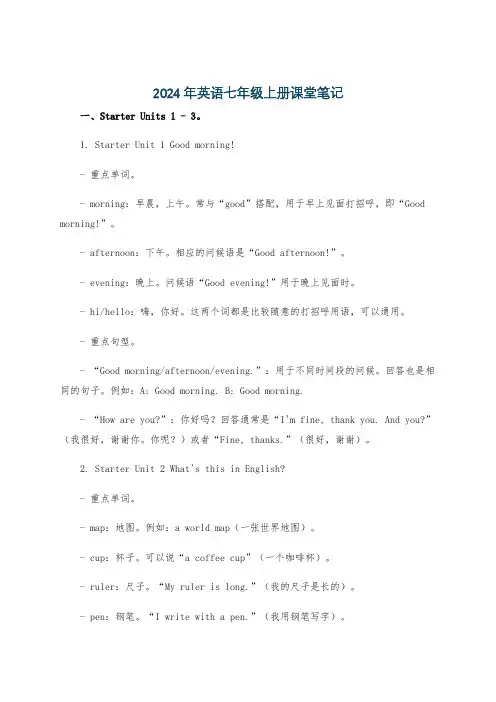
2024年英语七年级上册课堂笔记一、Starter Units 1 - 3。
1. Starter Unit 1 Good morning!- 重点单词。
- morning:早晨,上午。
常与“good”搭配,用于早上见面打招呼,即“Good morning!”。
- afternoon:下午。
相应的问候语是“Good afternoon!”。
- evening:晚上。
问候语“Good evening!”用于晚上见面时。
- hi/hello:嗨,你好。
这两个词都是比较随意的打招呼用语,可以通用。
- 重点句型。
- “Good morning/afternoon/evening.”:用于不同时间段的问候。
回答也是相同的句子。
例如:A: Good morning. B: Good morning.- “How are you?”:你好吗?回答通常是“I'm fine, thank you. And you?”(我很好,谢谢你。
你呢?)或者“Fine, thanks.”(很好,谢谢)。
2. Starter Unit 2 What's this in English?- 重点单词。
- map:地图。
例如:a world map(一张世界地图)。
- cup:杯子。
可以说“a coffee cup”(一个咖啡杯)。
- ruler:尺子。
“My ruler is long.”(我的尺子是长的)。
- pen:钢笔。
“I write with a pen.”(我用钢笔写字)。
- orange:作名词时,意为“橙子,橘子”;作形容词时,意为“橙色的”。
例如:an orange(一个橙子),an orange coat(一件橙色的外套)。
- 重点句型。
- “What's this in English?”:这个用英语怎么说?回答:“It'sa/an...”。
例如:A: What's this in English? B: It's a pen.- “Spell it, please.”:请拼写它。
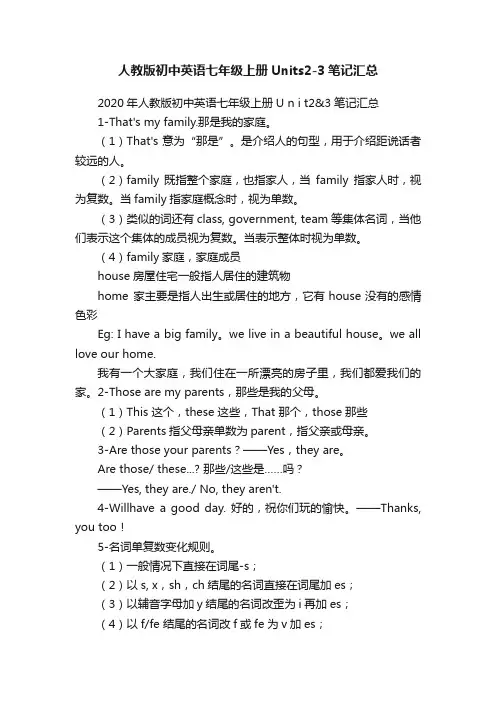
人教版初中英语七年级上册Units2-3笔记汇总2020年人教版初中英语七年级上册U n i t2&3笔记汇总1-That's my family.那是我的家庭。
(1)That's 意为“那是”。
是介绍人的句型,用于介绍距说话者较远的人。
(2)family 既指整个家庭,也指家人,当family指家人时,视为复数。
当family指家庭概念时,视为单数。
(3)类似的词还有class, government, team等集体名词,当他们表示这个集体的成员视为复数。
当表示整体时视为单数。
(4)family家庭,家庭成员house房屋住宅一般指人居住的建筑物home 家主要是指人出生或居住的地方,它有house没有的感情色彩Eg: I have a big family。
we live in a beautiful house。
we all love our home.我有一个大家庭,我们住在一所漂亮的房子里,我们都爱我们的家。
2-Those are my parents,那些是我的父母。
(1)This 这个,these 这些,That 那个,those那些(2)Parents指父母亲单数为parent,指父亲或母亲。
3-Are those your parents?——Yes,they are。
Are those/ these...? 那些/这些是……吗?——Yes, they are./ No, they aren't.4-Willhave a good day. 好的,祝你们玩的愉快。
——Thanks, you too!5-名词单复数变化规则。
(1)一般情况下直接在词尾-s;(2)以s, x,sh,ch结尾的名词直接在词尾加es;(3)以辅音字母加y结尾的名词改歪为i再加es;(4)以f/fe 结尾的名词改f或fe为v加es;(5)以字母o结尾有生命的加s,无生命的在词尾加s。
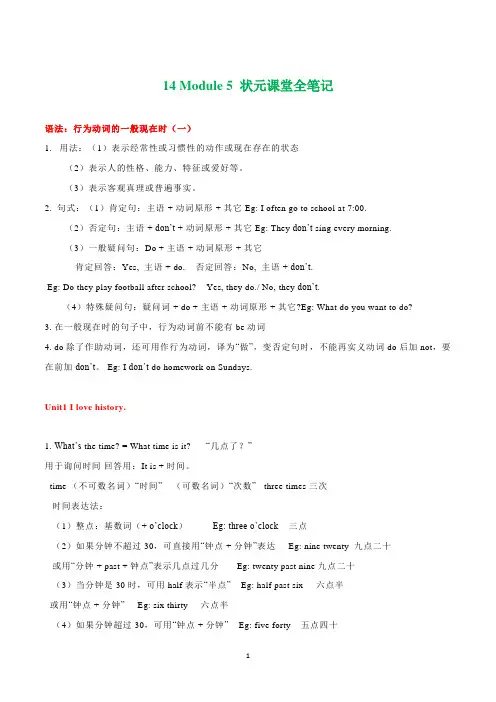
14 Module 5 状元课堂全笔记语法:行为动词的一般现在时(一)1. 用法:(1)表示经常性或习惯性的动作或现在存在的状态(2)表示人的性格、能力、特征或爱好等。
(3)表示客观真理或普遍事实。
2. 句式:(1)肯定句:主语 + 动词原形 + 其它 Eg: I often go to school at 7:00.(2)否定句:主语+ don’t +动词原形 + 其它 Eg: They don’t sing every morning.(3)一般疑问句:Do + 主语 + 动词原形 + 其它肯定回答:Yes, 主语 + do. 否定回答:No, 主语+ don’t.Eg: Do they play football after school? Yes, they do./ No, they don’t.(4)特殊疑问句:疑问词 + do + 主语 + 动词原形 + 其它?Eg: What do you want to do?3. 在一般现在时的句子中,行为动词前不能有be动词4. do除了作助动词,还可用作行为动词,译为“做”,变否定句时,不能再实义动词do后加not,要在前加don’t。
Eg: I don’t do homework on Sundays.Unit1 I love history.1. What’s the time? = What time is it? “几点了?”用于询问时间回答用:It is + 时间。
time (不可数名词)“时间”(可数名词)“次数” three times 三次时间表达法:(1)整点:基数词(+ o’clock)Eg: three o’clock 三点(2)如果分钟不超过30,可直接用“钟点 + 分钟”表达 Eg: nine twenty 九点二十或用“分钟 + past + 钟点”表示几点过几分 Eg: twenty past nine 九点二十(3)当分钟是30时,可用half表示“半点” Eg: half past six 六点半或用“钟点 + 分钟” Eg: six thirty 六点半(4)如果分钟超过30,可用“钟点 + 分钟” Eg: five forty 五点四十或“(60-分钟数) + to + (时钟数+1)”表达 Eg: twenty to six 五点四十2.maths(不可数名词)“数学”作主语时,谓语动词用单数。
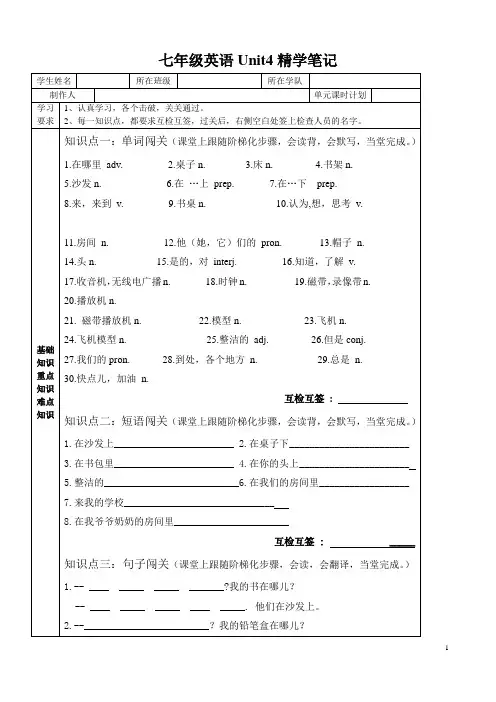
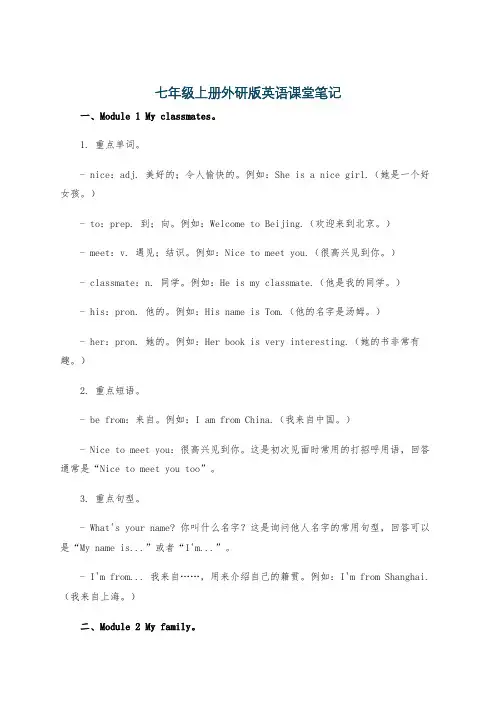
七年级上册外研版英语课堂笔记一、Module 1 My classmates。
1. 重点单词。
- nice:adj. 美好的;令人愉快的。
例如:She is a nice girl.(她是一个好女孩。
)- to:prep. 到;向。
例如:Welcome to Beijing.(欢迎来到北京。
)- meet:v. 遇见;结识。
例如:Nice to meet you.(很高兴见到你。
)- classmate:n. 同学。
例如:He is my classmate.(他是我的同学。
)- his:pron. 他的。
例如:His name is Tom.(他的名字是汤姆。
)- her:pron. 她的。
例如:Her book is very interesting.(她的书非常有趣。
)2. 重点短语。
- be from:来自。
例如:I am from China.(我来自中国。
)- Nice to meet you:很高兴见到你。
这是初次见面时常用的打招呼用语,回答通常是“Nice to meet you too”。
3. 重点句型。
- What's your name? 你叫什么名字?这是询问他人名字的常用句型,回答可以是“My name is...”或者“I'm...”。
- I'm from... 我来自……,用来介绍自己的籍贯。
例如:I'm from Shanghai.(我来自上海。
)二、Module 2 My family。
- family:n. 家;家庭。
例如:This is my family.(这是我的家庭。
)- father:n. 父亲;爸爸。
例如:My father is a teacher.(我的爸爸是一名教师。
)- mother:n. 母亲;妈妈。
例如:My mother likes cooking.(我的妈妈喜欢做饭。
)- sister:n. 姐妹。
例如:My sister is a student.(我的姐姐是一名学生。
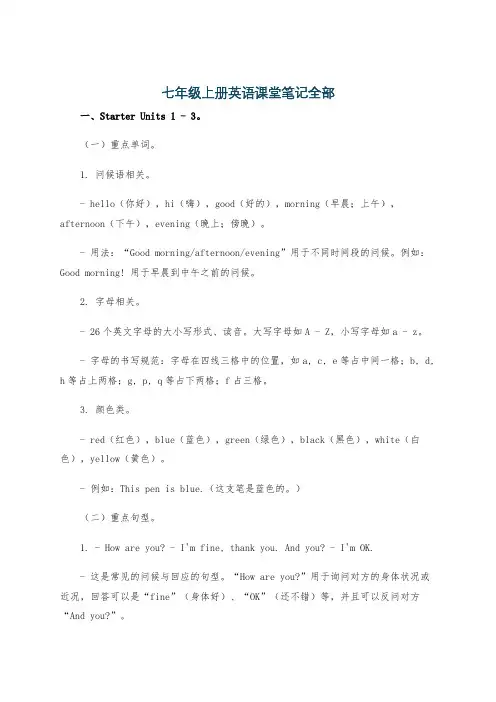
七年级上册英语课堂笔记全部一、Starter Units 1 - 3。
(一)重点单词。
1. 问候语相关。
- hello(你好),hi(嗨),good(好的),morning(早晨;上午),afternoon(下午),evening(晚上;傍晚)。
- 用法:“Good morning/afternoon/evening”用于不同时间段的问候。
例如:Good morning! 用于早晨到中午之前的问候。
2. 字母相关。
- 26个英文字母的大小写形式、读音。
大写字母如A - Z,小写字母如a - z。
- 字母的书写规范:字母在四线三格中的位置,如a, c, e等占中间一格;b, d, h等占上两格;g, p, q等占下两格;f占三格。
3. 颜色类。
- red(红色),blue(蓝色),green(绿色),black(黑色),white(白色),yellow(黄色)。
- 例如:This pen is blue.(这支笔是蓝色的。
)(二)重点句型。
1. - How are you? - I'm fine, thank you. And you? - I'm OK.- 这是常见的问候与回应的句型。
“How are you?”用于询问对方的身体状况或近况,回答可以是“fine”(身体好)、“OK”(还不错)等,并且可以反问对方“And you?”。
2. - What's this/that in English? - It's a/an...- 用于询问某个物品用英语怎么说。
例如:What's this in English? It's a book.(这个用英语怎么说?它是一本书。
)注意a用于以辅音音素开头的单词前,an 用于以元音音素开头的单词前,如an apple。
二、Unit 1 My name's Gina.(一)重点单词。
1. 名字相关。
- name(名字),first name(名),last name/family name(姓)。
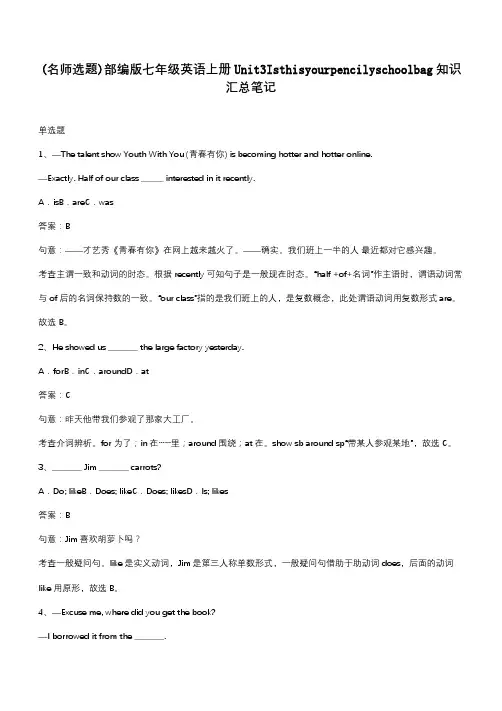
(名师选题)部编版七年级英语上册Unit3Isthisyourpencilyschoolbag知识汇总笔记单选题1、—The talent show Youth With You (青春有你) is becoming hotter and hotter online.—Exactly. Half of our class ______ interested in it recently.A.isB.areC.was答案:B句意:——才艺秀《青春有你》在网上越来越火了。
——确实。
我们班上一半的人最近都对它感兴趣。
考查主谓一致和动词的时态。
根据recently可知句子是一般现在时态。
“half +of+名词”作主语时,谓语动词常与of后的名词保持数的一致。
“our class”指的是我们班上的人,是复数概念,此处谓语动词用复数形式are。
故选B。
2、He showed us ________ the large factory yesterday.A.forB.inC.aroundD.at答案:C句意:昨天他带我们参观了那家大工厂。
考查介词辨析。
for为了;in在……里;around围绕;at在。
show sb around sp“带某人参观某地”,故选C。
3、________ Jim ________ carrots?A.Do; likeB.Does; likeC.Does; likesD.Is; likes答案:B句意:Jim喜欢胡萝卜吗?考查一般疑问句。
like是实义动词,Jim是第三人称单数形式,一般疑问句借助于助动词does,后面的动词like用原形,故选B。
4、—Excuse me, where did you get the book?—I borrowed it from the ________.A.cinemaB.libraryC.parkD.station答案:B句意:——打扰了,你在哪儿得到的这本书?——我从图书馆借的。
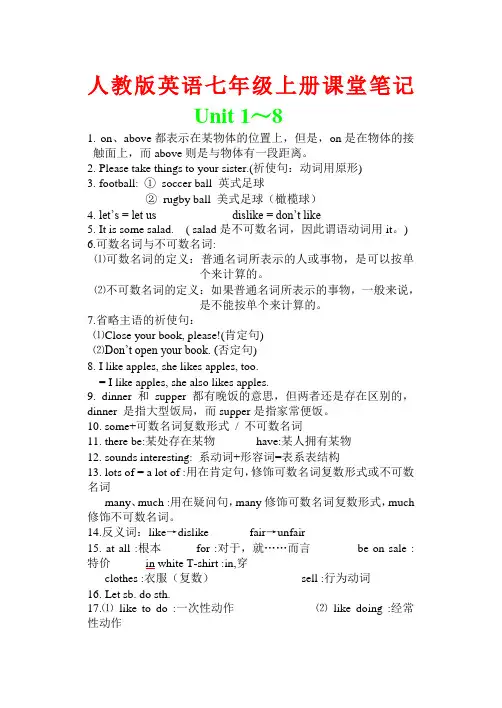
人教版英语七年级上册课堂笔记Unit 1~81. on、above都表示在某物体的位置上,但是,on是在物体的接触面上,而above则是与物体有一段距离。
2. Please take things to your sister.(祈使句:动词用原形)3. football: ①soccer ball 英式足球②rugby ball 美式足球(橄榄球)4. let’s = let us dislike = don’t like5. It is some salad. ( salad是不可数名词,因此谓语动词用it。
)6.可数名词与不可数名词:⑴可数名词的定义:普通名词所表示的人或事物,是可以按单个来计算的。
⑵不可数名词的定义:如果普通名词所表示的事物,一般来说,是不能按单个来计算的。
7.省略主语的祈使句:⑴Close your book, please!(肯定句)⑵Don’t open your book. (否定句)8. I like apples, she likes apples, too.= I like apples, she also likes apples.9. dinner和supper都有晚饭的意思,但两者还是存在区别的,dinner 是指大型饭局,而supper是指家常便饭。
10. some+可数名词复数形式/ 不可数名词11. there be:某处存在某物have:某人拥有某物12. sounds interesting: 系动词+形容词=表系表结构13. lots of = a lot of :用在肯定句,修饰可数名词复数形式或不可数名词many、much :用在疑问句,many修饰可数名词复数形式,much 修饰不可数名词。
14.反义词:like→dislike fair→unfair15. at all :根本for :对于,就……而言be on sale :特价in white T-shirt :in,穿clothes :衣服(复数)sell :行为动词16. Let sb. do sth.17.⑴like to do :一次性动作⑵like doing :经常性动作18. How much is this bag ?=What’s the price of this bag ?19.多个形容词在名词前时,先说大小形状再说颜色,描述性的形容词放在最前。
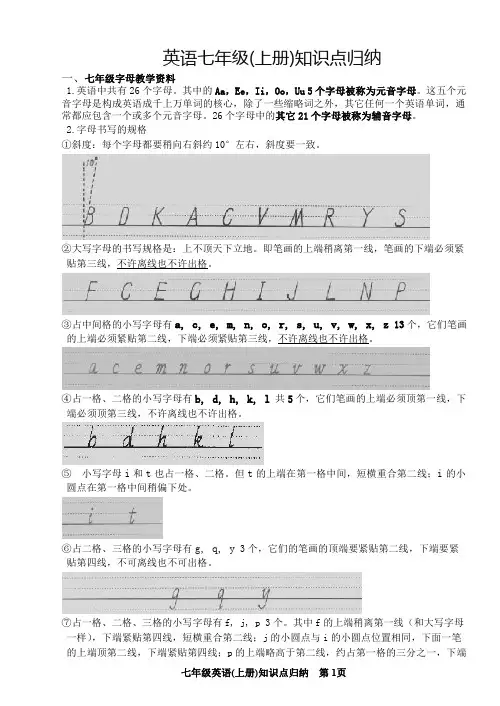
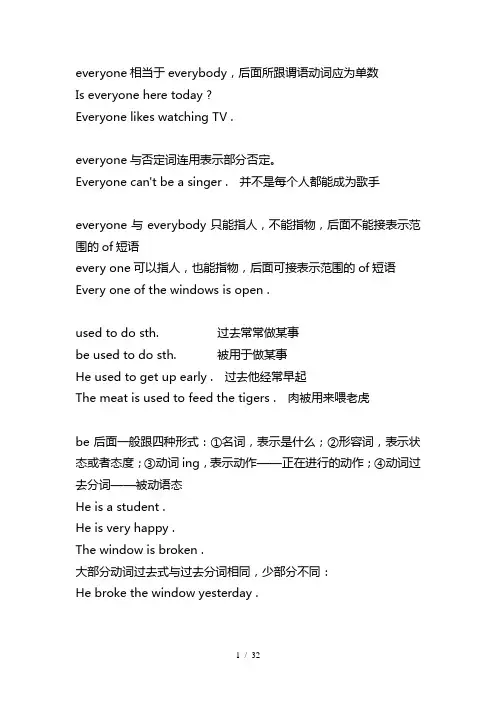
everyone相当于everybody,后面所跟谓语动词应为单数Is everyone here today ?Everyone likes watching TV .everyone与否定词连用表示部分否定。
Everyone can't be a singer . 并不是每个人都能成为歌手everyone与everybody只能指人,不能指物,后面不能接表示范围的of短语every one可以指人,也能指物,后面可接表示范围的of短语Every one of the windows is open .used to do sth. 过去常常做某事be used to do sth. 被用于做某事He used to get up early . 过去他经常早起The meat is used to feed the tigers . 肉被用来喂老虎be后面一般跟四种形式:①名词,表示是什么;②形容词,表示状态或者态度;③动词ing,表示动作——正在进行的动作;④动词过去分词——被动语态He is a student .He is very happy .The window is broken .大部分动词过去式与过去分词相同,少部分不同:He broke the window yesterday .be动词在一般疑问句的肯定回答中不能缩写Yes , he's . (×) Yes , he is . (√)grade也可表示“等级、成绩”She got good grades . 她取得了好成绩over [adv.] 超过;遍及;翻倒;结束There are over fifty students in Class 6 . 六班有五十多名学生We have friends all over the world . 我们的朋友遍天下Don't knock over the glasses . 不要把那些玻璃杯子打翻了Class is over . 下课了look、see、watch、read的区别①look指集中注意力地看,强调“看”的动作。
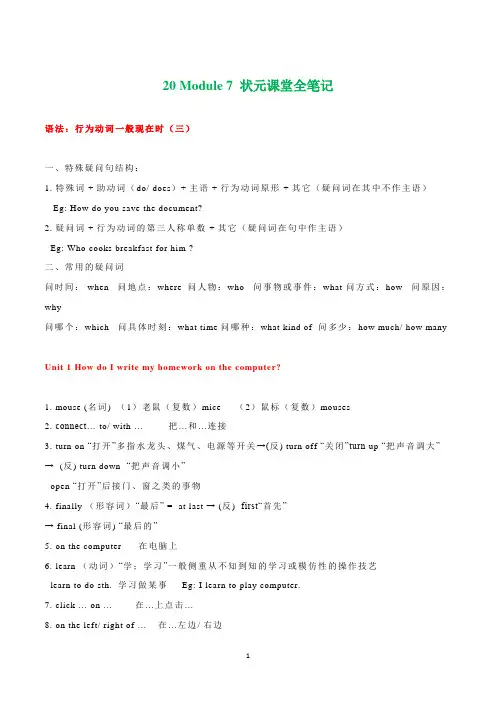
20 Module 7 状元课堂全笔记语法:行为动词一般现在时(三)一、特殊疑问句结构:1. 特殊词 + 助动词(do/ does)+ 主语 + 行为动词原形 + 其它(疑问词在其中不作主语)Eg: How do you save the document?2. 疑问词 + 行为动词的第三人称单数 + 其它(疑问词在句中作主语)Eg: Who cooks breakfast for him ?二、常用的疑问词问时间: when 问地点:where 问人物:who 问事物或事件:what问方式:how 问原因:why问哪个:which 问具体时刻:what time问哪种:what kind of 问多少:how much/ how many Unit 1 How do I write my homework on the computer?1. mouse (名词) (1)老鼠(复数)mice (2)鼠标(复数)mouses2. connect… to/ with …把…和…连接3. turn on “打开”多指水龙头、煤气、电源等开关→(反) turn off “关闭”turn up “把声音调大”→ (反) turn down “把声音调小”open “打开”后接门、窗之类的事物4. finally (形容词)“最后” = at last → (反) first“首先”→ final (形容词) “最后的”5. on the computer 在电脑上6. learn (动词)“学;学习”一般侧重从不知到知的学习或模仿性的操作技艺learn to do sth. 学习做某事 Eg: I learn to play computer.7. click … on …在…上点击…8. on the left/ right of …在…左边/ 右边Eg: There is a hospital on the left of the bookshop.9. use (动词) “使用”use… to do sth. 用…做某事 Eg: I use pen to write letters.(名词) “用处;用途”→ useful(形容词)“有用的”10. save the document 保存文件save (动词) (1)保存;储存(2)挽救;拯救(3)节省;节约11. box (复数) boxes (1)(计算机屏幕上的)方框(2)盒子(3)a box of …一盒…12. print the document 打印文件13. what about… = how about …“...怎么样”后接名词,代词或动名词Eg: What about going swimming ?14. paper (不可数名词) “纸” a piece of paper 一张纸 five pieces of paper 五张纸15. put … in …把…放进… Eg: Put the books in the box.16. of course 当然17. open a new document 打开一个新文件18. use the keyboard 使用键盘Unit 2 When do you use a computer?1. share …with…与…分享… Eg: The little boy often share his food with his younger sister.2. in Australia 在澳大利亚 Australia (名词) 澳大利亚→ Australian(形容词)澳大利亚的3. a manager of a company 一家公司的经理4. talk to/ with sb. 与某人交流 Eg: My teacher is talking with Xiaoming’s parents.5. go on the Internet 上网6. check the times of trains 查询火车时刻7. travel (名词) “旅行”一般指国外或远方旅行(动词)“旅行”8. plan (名词) “计划” make a plan 制定计划plan (动词) “计划” plan to do sth 计划做某事9. buy ticket 买票buy (动词) “买”→ sell (动词) “卖” buy sb. sth. = buy sth. for sb.给某人买某物Eg: My dad buys a book for me. = My dad buys me a book.10. listen to music 听音乐 listen to sb. 听某人说11. watch movies = see films 看电影 go to the movies 去看电影12. night (名词) “夜晚”at night “在夜晚”但前有every修饰时,省略at; Eg:every night13. at school 学校14. on the Internet 在网上15. search for (sb./ sth.) “搜寻;查找(某人/某物)” search + 地点“搜寻某地”16. information (不可数名词)“信息”可用much, a lot of, some, any等词修饰,表示“一条信息”时用 a piece of information.17. do one’s homework 做作业18. check emails 查邮件19. at home 在家20. send (动词) “发送” send sb. sth. = send sth.to sb. 发给/寄给某人某物Eg: He sends a letter to me. = He sends me aletter.21. play (computer) games 玩(电子)游戏22. sometimes (副词) “有时;不时”= at timessometimes, some times, sometime 和 some time区别:分开“一段时间”(some time),相聚“某一时刻”(sometime);“有时”相聚加s(sometimes),分开“几次”加s (some times)23. work for a company 为一家公司工作24. clothes(名词)“衣服(总称)”不能用不定冠词a/ an,指示代词this/ that, 数词等修饰,但可以用定冠词the, 指示代词these/ those, some, many等修饰。
1。
引语为一般陈述句,变为间接引语时一般由that引导(可省略)2。
如果直接引语中的主语为第一人称,变为间接引语时人称要随主语作适当变化3。
如果引述动词为一般过去时,间接引语中动词的时态一般推移到过去时间4。
其他变化指示代词时间状语地点状语动词this—that today-that day here—there come--gothese-—those now-thenRead the passage. Describe the sentences are from the radio review (R) or the newspaper review (N)1.“ It’s an excellent film,with terrific special effects。
"2.“ Although the special effects are fantastic, it's a disappointing film。
”3.“The film is very long, and becomes boring。
”4.“Elijah Wood’s scenes are boring.5.“Ian Mckellen is much better and his scenes are great。
”R ead the passage then answer the questions1。
Read Paragraph 2 and answer the following questions1). What did Chen Huan say the type of Pirates of the Caribbean?2)。
What did Chen Huan say about the actors?2。
Read Paragraph 3 and answer the following questions1)。